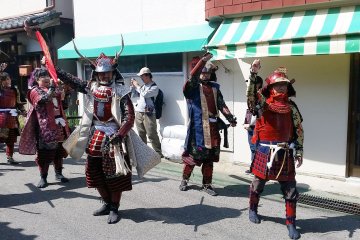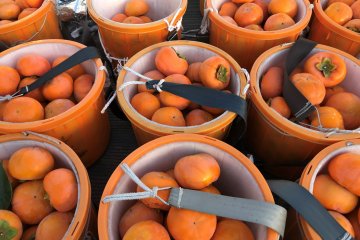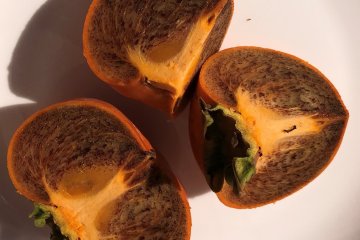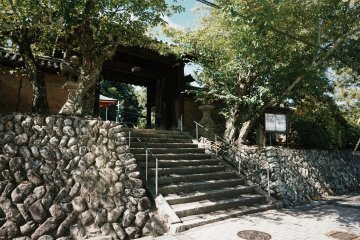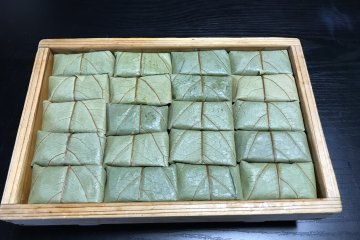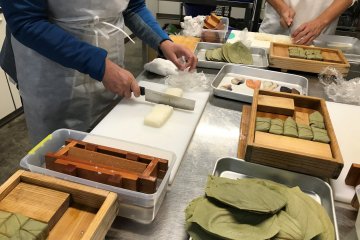Kuwaraku is a sushi-maker and a small restaurant near Kudoyama Station on the Nankai train line that connects Osaka's Namba with Koyasan. This place serves one dish: kakinoha-zushi, and it is rather famous now!
Not many people stop in Kudoyama on their way to Koyasan, although the famous temple Jisonin is located here. If you do get off the train, you can learn about the history of the Sanada, a samurai clan, visit the temple where Kobo Daishi's mother lived, pick some persimmon at one of the orchards in autumn, or enjoy shopping for persimmon products during other times of the year at the Kudoyama Michi no Eki called "Kaki no Sato" (Persimmon Village). Well, and you can also enjoy a kakinoha-zushi-making experience, and then eat what you made in a nearby traditional Japanese house (reservations needed).
The sushi chef, owner of the business and owner of the nearby house is Mr. Akihiro Oka. He provides instructions and demonstrates how to wrap your sushi professionally.
Sushi wrapped in a persimmon leaf is a traditional way of eating sushi in the north of the Kii Peninsula. This is the area where a lot of persimmon are grown. For example, in the Katsuragi and Kudoyama areas of Wakayama Prefecture, and in the Nishi-Yoshino area of Nara prefecture. You can visit the Kushigaki Village of Katsuragi too. These areas are located near the upper Kinokawa River, later named Yoshino River.
You should not make the mistake and eat this sushi while still wrapped in the persimmon leaf. Unwrap it, eat the sushi and discard the leaf, which serves only as packing and to keep the sushi protected because the persimmon leave as anti-bacterial properties.
But why was the sushi wrapped in the persimmon leaves in the first place?
Well, in the old days in was a long way from the coast to the towns and villages in the mountains. Fish had to be preserved before it was transported because it took many days to reach the destination. Preservation of fish was done by salt and also by vinegar. This meant that the fish arrived too salty and sour and it was difficult to eat. Put it on rice though, and the salty-sour morsels of fish suddenly taste good. This was probably how this unique dish was born.
Mackerel and salmon are the traditional choices but nowadays you also get shrimp, red snapper, sea bream and eel. The vegetarian option is shiitake mushroom and the mushrooms are grown in Wakayama Prefecture. The soy sauce used here is made in Yura Town. All kakinoha-zushi here is hand-made and no preservatives are added.
Typically it comes in a box, either a wooden box or cardboard, and in numbers of 9, 12 or 20 pieces. Since the sushi is well preserved, a box of kakinoha-zushi can now even be shipped to distant places in Japan as long as the shipping does not take longer than 2 days. This service is available from Kuwaraku. You can put in your order online on their website and get your sushi delivered to Osaka or Tokyo the next day.
This sushi-maker and restaurant has been featured in the Japanese media, including on TV and in newspapers and magazines, many times since 2004. Well, it is a famous place but looks quite unassuming. The entrance to the restaurant can easily be missed, hence look out for the signs.
I went to Kuwaraku with a friend in autumn 2020 and we enjoyed our kakinoha-zushi making experience a lot. It was great fun and the activity is suitable for couples or a group of friends.
You can enjoy the sushi that you made yourself or the sushi made by Mr. Oka as part of a lunch set. There are several options for lunch sets. The base is kakinoha-zushi, plus miso soup, then you can add tempura and tai kamameshi (sea bream on rice cooked in an iron pot). The price range is 1,100 yen to 2,700 yen. Lunch time is from 11 am to 2 pm.
The meal can be taken in the traditional house near the restaurant, which can also be rented for the night. The owner of the house is also Mr. Oka. This is the perfect food and the perfect setting for a break before or after your visit to the Jisonin Temple or the Sanada Museum, and before you continue your journey to the top of Koyasan, or travel back to Osaka.



